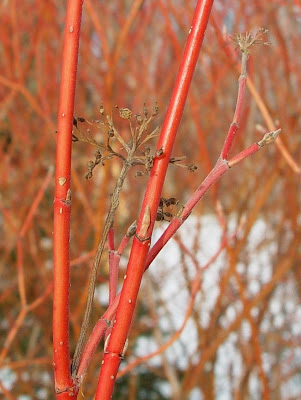
This morning was cold again,
with snow flurries swirling on light breezes.
Two Red-bellied Woodpeckers
Melanerpes carolinus,
one male and one female,
live in the wild woods.
They come to the suet blocks at the
feeder station to load up on fat
and supplement their diet of insects
gleaned from between the crevices of tree bark.
Today, the male rested a while
with his head tucked down
among the feathers on his shoulders.
All we could see of his head was
a small red circle.
Then, he popped his beak out
and took a look around,
making sure all was safe
for a few more minutes of cozy rest.

 Two varieties of dogwood brighten the edge of the wild wild woods. Cornus alba 'Ivory Halo' displays dark rich red twigs in the winter. Cornus sericea 'Cardinal' glows with bright crimson bark, quite brilliant in the sunlight against the snow. They both provide a fine tangle for the red feathered birds (Cardinals, House Finches, Redpolls) to hide in plain sight.
Two varieties of dogwood brighten the edge of the wild wild woods. Cornus alba 'Ivory Halo' displays dark rich red twigs in the winter. Cornus sericea 'Cardinal' glows with bright crimson bark, quite brilliant in the sunlight against the snow. They both provide a fine tangle for the red feathered birds (Cardinals, House Finches, Redpolls) to hide in plain sight.





















 Among the birds in the wild woods this winter is the Northern Flicker. This one spent quite a while today seeking insects under the tree bark. Since the sun was shining on his tree, he took a break with feathers fluffed up, then demonstrated how far his neck could reach around back . . .
Among the birds in the wild woods this winter is the Northern Flicker. This one spent quite a while today seeking insects under the tree bark. Since the sun was shining on his tree, he took a break with feathers fluffed up, then demonstrated how far his neck could reach around back . . .